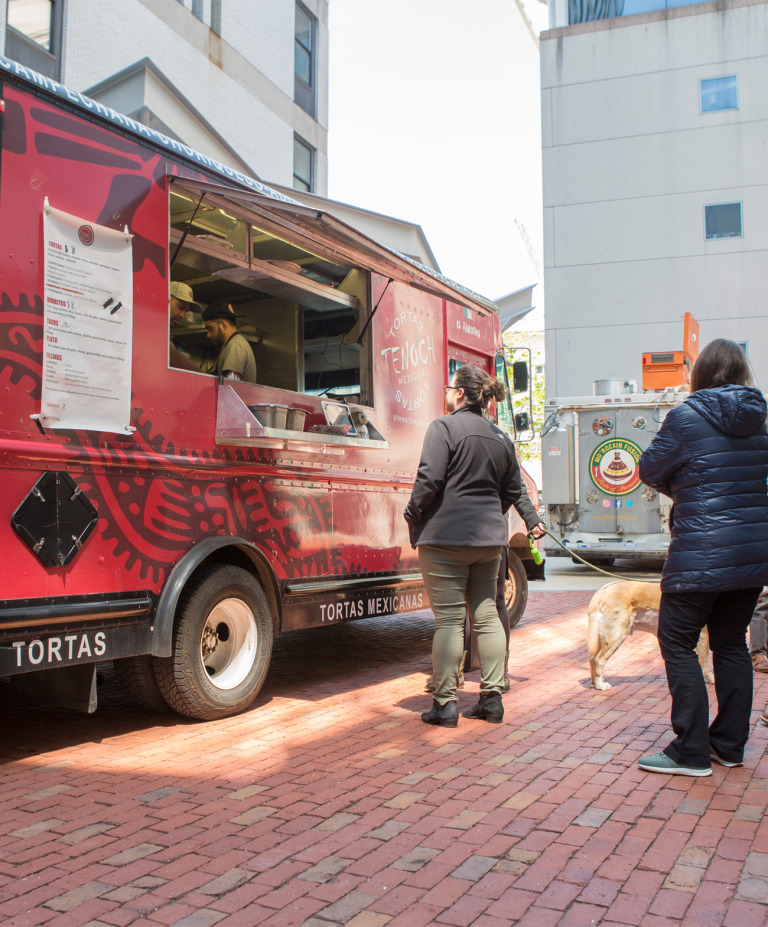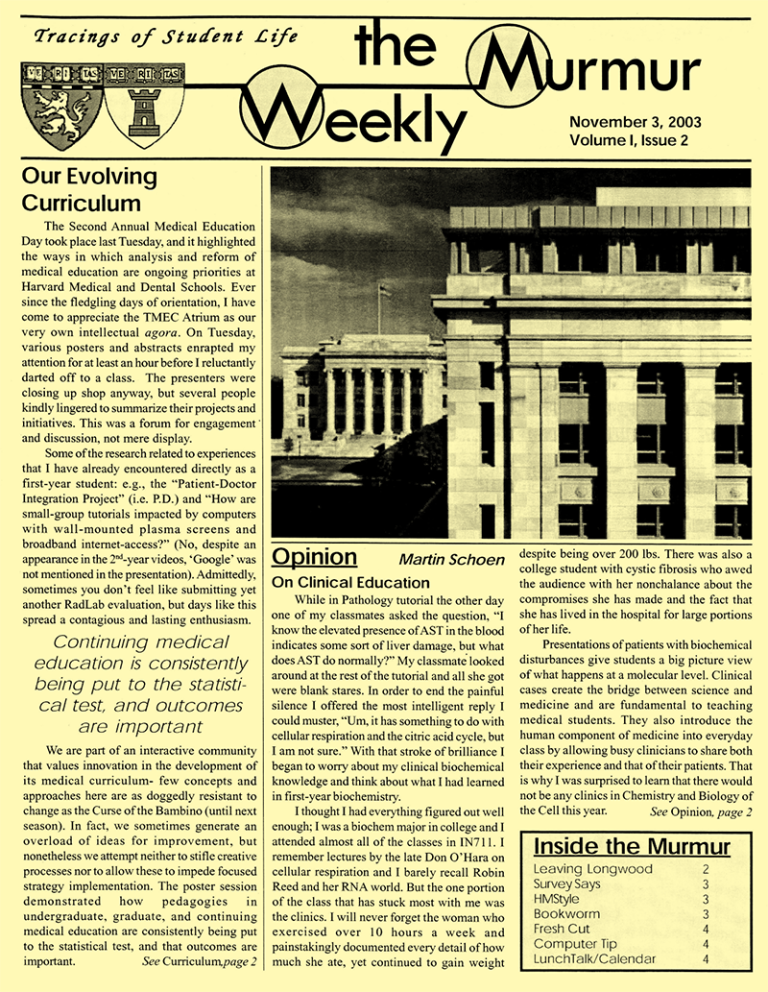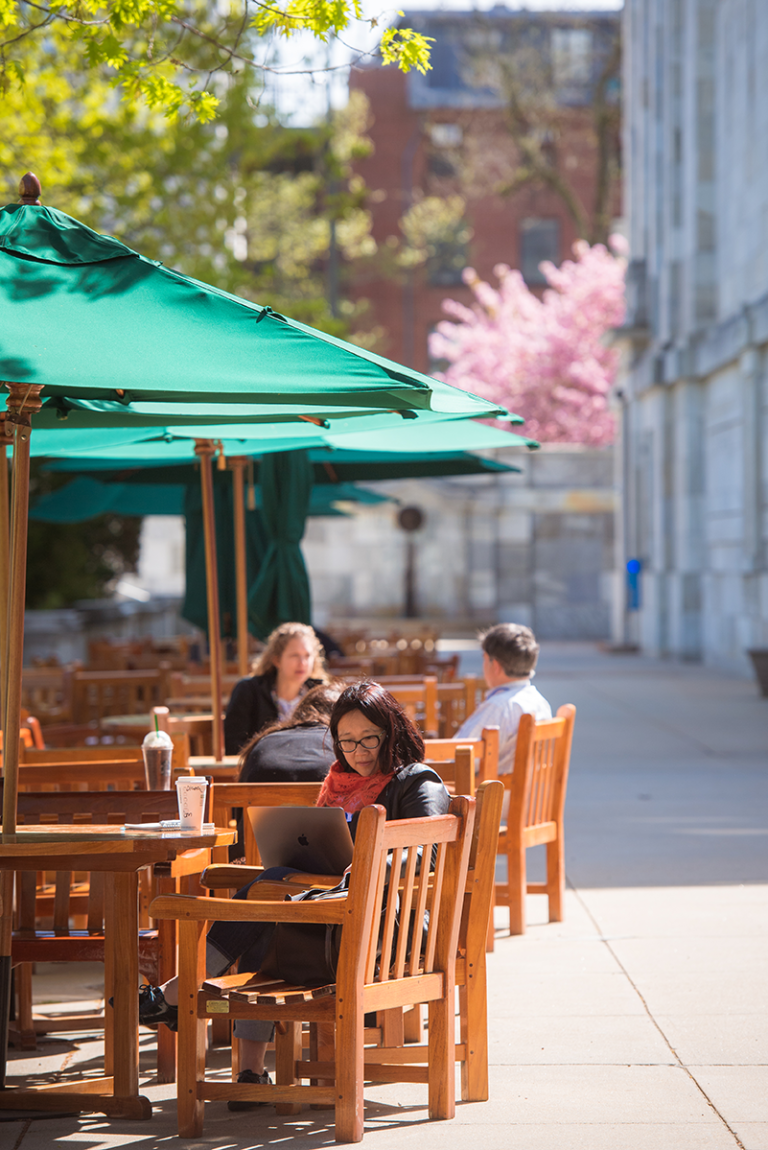Restaurant Tour

Last summer, as the global pandemic raged through Los Angeles, I decided to sort through boxes in my attic. Among the mementos I stumbled across were twenty issues of The Weekly Murmur: Tracings of Student Life, a newsletter published at HMS from October 2003 to April 2004. Reading them, I was touched, delighted, and amused; the articles were informal snapshots of my HMS and Harvard School of Dental Medicine classmates and captured our last year together prior to scattering to our clinical clerkships. As far as I know, the cache I found is the only remaining physical copy of this series, and I suspect my chief reason for saving them from the recycling bin was my nostalgic attachment as the publication’s editor-in-chief.
While there had been previous iterations of student newsletters, some going by Murmurs or Rounds, none were circulating by the time I arrived at the Longwood campus in the fall of 2002. My own inspiration for dispatching a communication at an ambitious weekly pace was not from any high-minded literary aspiration, but rather a prosaic need for a guide to free food on campus. I had started my second year with sore memories of spending my first year haplessly roaming the hallways of the Tosteson Medical Education Center trying to track the source of savory smells by listening for nearby whoops and cheers from lucky bystanders. The bevy of posters taped to the doors and columns in the TMEC atrium proved to be a poor resource, as they became outdated quickly—or were smothered by competitors. Other students voiced similar frustrations over narrowly missing any delectable meal opportunity, while concurrently, student organizers despaired of filling their rooms with attendees. With an altruistic desire to solve our problem of food waste, I recruited several of my classmates, all enthusiastic and gifted writers and editors, to contribute content to what I envisioned would be a single-fold, four-page weekly publication that would feature relevant refreshments in the upcoming week’s list of student events on its back page.
To the table
Food was reliable coinage for coaxing our diverse and independent-minded student body to serve as an audience outside the classroom, and quickly established our readership. From a class of 165 students, we had 165 future leaders in medicine and dentistry, or so we were told. This message likely fueled the high ratio of student-led organizations to number of students on campus. Interest groups, teams, and charities cheerfully vied for our attention by offering enticing hot or cold foods at their events.
We made room for them all on the back page.
There was “lunch provided” at the Music Society’s first meeting on Monday, as well as later on Thursday for “Beautiful Day in the Neighborhood: Structured Violence, Service and the New Community Medicine.” You could have a “free Indian food lunch” while sitting in on a talk on “Yoga Research and Therapy.” I am still entranced by titles such as “How to Deliver a Baby on an Airplane with Your Shoestrings and a Newspaper,” sponsored by the Low-tech Medicine Interest Group, which included a “non-pizza” dinner, and the reception and photo exhibit, “Don’t Turn Away, Life in Countries Affected by AIDS,” presented by the Harvard Medical Student AIDS Action Initiative.

Critical reviews
Other sections of the newsletter reflected the personalities of their contributors. The “Opinion” and “Topical” columns, edited by Martin Schoen, MD ’06; Mario Luis Ramirez, MD ’07; and Jason Sanders, MD ’08, captured the often humorous or poignant observations and rants we expressed as we tried to work out our places as the newest members of a hallowed profession and institution. In one of these columns, Jennifer Broder, MD ’06, considered how we could maintain empathy as physicians when the “initial reaction to pain and sadness is to try to protect ourselves by creating distance between ourselves and our patients.” In another, Joseph Wright, MD ’07, described an experience prior to medical school of enjoying a “delicious, subtle, creative, and spicy” meal that included a “spectacular crispy fish that changed my mind about crispy fish,” while also channeling the evolving ethics surrounding drug company-sponsored dinners. Felipe Jain, MD ’08, used another column to rebut a prominent Harvard administrator’s statement that U.S. trade policies had no direct bearing on the public health crises of AIDS and malnutrition in Africa by pointing out that at times tariffs cost “$100 billion, or more than twice all development aid,” and the interest due on national debts was “equal to or more than that allocated for health.”
A theme opined on frequently in these columns was the changing nature of our curriculum, which seemed to exist in a constant revisionist state. We went from flexing our ability to memorize facts to learning patients’ life stories, and later, trying to determine the merits of sequential versus longitudinal clinical rotations; members of our class volunteered for the first of such innovative tracks. Schoen worried that dry subject matter like biochemistry would lose “human context” without clinic time, citing a compelling case study of a woman who “exercised over 10 hours a week and painstakingly documented every detail of how much she ate, yet continued to gain weight despite being over 200 lbs.” Christopher Russell, MD ’07, responded to first-years fretting over the increasing difficulty of course exams by asking, “is a curriculum that expects more from students a burden or a service to students?” given the exhausting breadth of our collective extracurricular activities of “trying to change the world.” Often, it felt as if we had inadvertently embarked on a form of extreme participatory research for training as compassionate and competent physicians and dentists. I guess more than fifteen years later I can accept the possibility that this interpretation of our experience could be both intentional and true.
With fork in hand
In any case, it was likely that none of us felt completely at ease with the yearly shifts in the pedagogy, and early side-eye comparisons were perhaps inevitable. We had already entered the School through two separate tracks—HST (Health Sciences and Technology; now the London Society), which cycled thirty students in classes at both HMS and MIT, and New Pathway (now Pathways), where the remaining 135 students received small group training as members of either the Castle, Cannon, Holmes (now Hinton), or Peabody academic societies.
Harry Potter jokes notwithstanding, small rivalries continued even outside the Society Olympics. Columns like “Survey Says,” edited by Dorothy Weiss, MD ’06; Thomas Kozhimannil, MD ’06; and Vanessa Henke, MD ’07, and “HMStyle” by Heidi Goodarzi, MD ’07; and Yetsa Tuakli-Wosornu, MD ’07, delicately and humorously exposed these divisions while giving a voice to dozens of students on campus. A survey on gratitude during the holidays elicited responses like “I’m thankful that my one-month-old son hasn’t peed on me yet while [I’ve been] changing his diaper,” by James Olsen, our classmate in the dental school, while another on what was missed most from vacation included “having time to watch Oprah,” offered by Tiffany Jackson, MD ’07; “my bed,” by Kelly (Tiger) Edwards, MD ’08; and “someone else doing my laundry,” by Anonymous. Meanwhile, “HMStyle” broadcast the stylistic and sartorial choices of one or more persons of interest on campus in swoonworthy detail, with photographic evidence to boot. I finally understand what it meant to look like “a little bit of Harvard and a lot of California rolled into one”—it involves a Brooks Brothers sweater and “grungy … cargo shorts.”
Kit Lo, MD ’06, Yana Pikman, MD ’07, and Sanders eloquently and persuasively reminded us that movies, books, and, yes, our own creative writing and photography held power and significance, through the material they presented in “Fresh Cut,” “Bookworm,” “Reviews,” and “Arts.” One poem, penned by Kai-How Farh, MD ’09, reverberates with me even more now that I’ve felt this as a medical student, pathologist, family member, and friend.
“I like to think that you were only a guest. / You borrowed this body, learned what you could, / and when it was time, moved on. I hope you loved it, / I hope you learned as much here as I have.”

“Leaving Longwood,” edited by Mária Némethy, MD ’07, and Ramirez, described epic adventures and food sagas throughout Boston and Cambridge. There was also a special edition splashed across two issues: “Cutting the Vandy Cord,” referring of course to Vanderbilt Hall, our Longwood campus dormitory. The merits and demerits of nearby neighborhoods were hotly discussed. Charles (Ted) Lord, MD ’06, memorably praised Jamaica Plain, the home of El Oriental de Cuba, where you could buy a “Cuban sandwich (smoked pork and ham) and a batida (tropical fruit shake; one flavor Morir soñando [or] ‘to die dreaming.’ Say no more.)” As a rejoinder, Wright enthused about Inman Square’s Punjabi Dhaba, where “if a group of Punjabi truck drivers were to walk through the door, they’d have to order and listen carefully for their shouted-out numbers just like everyone else. Please don’t make Mr. P. Dhaba shout twice… when people don’t listen for their numbers, he gets this look on his face like he wishes he were somewhere very far away. Then he shouts out the number again. People! Listen for your number!”
One of my personal favorites for rereading has been “Eat Your Heart Out,” otherwise known as our food recipe column, written by Allon Beck, MD ’06. Describing his process for making potato latkes, he started by setting the tone, “there are differing schools of thought about latkes: some like them thick, some thin, some fine in texture, others coarse. Here is my favorite recipe: I believe latkes need to be simple, very finely textured, and wonderfully crisp. To achieve this, the potatoes need to be grated on a fine grater by hand, and they must be fried in very hot oil. Don’t use olive oil—it doesn’t fry hot enough, and you risk burning the oil.” Another recipe for a “sumptuous hot drink” for “inner warmth” aptly notes that “the origin of mulled wine is shrouded in mystery, as is the origin of the word ‘mull’ in this context.”
Today’s fare
At some point on every nonholiday weekend, Sarun Charumilind, MD ’07, Schoen, and I would face a daunting blank page on the computer screen and work to fill it with articles cajoled or extracted under mild duress from our classmates. What followed every time was an architectonic tour de force as three columns appeared with sentences wrapped neatly around photos taken by Keith Michael, MD ’06. By the end of our tenure, we even had an online presence and dedicated email addresses, thanks to Michael Lu, MD ’07, and Shannon McDonald, MD ’09.
Malcolm Cox, MD ’70, then the School’s dean for medical education, and various faculty members encouraged us and weren’t afraid to lean in to respond to our concerns on thorny topics such as rising medical student debt. Some would contribute their own original pieces. In hindsight, those latter topics were also highly relevant, such as an article by Deborah Anderson, then an HMS lecturer on medicine at Brigham and Women’s Hospital, on the challenges of “nurturing women researchers at HMS.” The Office of Medical Education and the HMS Student Council generously funded our work.
More than a decade later, it appears I may have unwittingly arrived full circle. I created and continue to act as editor-in-chief of a one-page newsletter from the laboratory and pathology departments, which is emailed monthly to more than eight thousand physicians who work with me at Kaiser Permanente Southern California. During the past year, this newsletter has been used to share key information about SARS-CoV-2 and innumerable related updates to our menu of laboratory tests.
I know we are far from solving any world problems with newsletters current or past. Even so, it was striking to me that so many topics from The Weekly Murmur are the same ones our society continues to probe and debate today, and likely tomorrow as well. My second-year self would ask whether there is a point to learning how to become a “compassionate and competent” physician or dentist when all the original problems remain unsolved. I suppose one answer might be contained in the narrative form known as the hero’s journey, a series of templated challenges that end with a true and decisive transformation—of the hero. Perhaps, after all of this, we are at once a work in progress and an outcome by which our strivings can be measured.
JiYeon Kim, MD ’07, a clinical pathologist, is the physician director for the esoteric chemistry, special coagulation, and immunology lab departments at Kaiser Permanente Southern California Regional Reference Laboratories, and provides strategy and oversight for the region’s laboratory information systems.
Images: John Soares (food truck); Gretchen Ertl (tables on Quad)